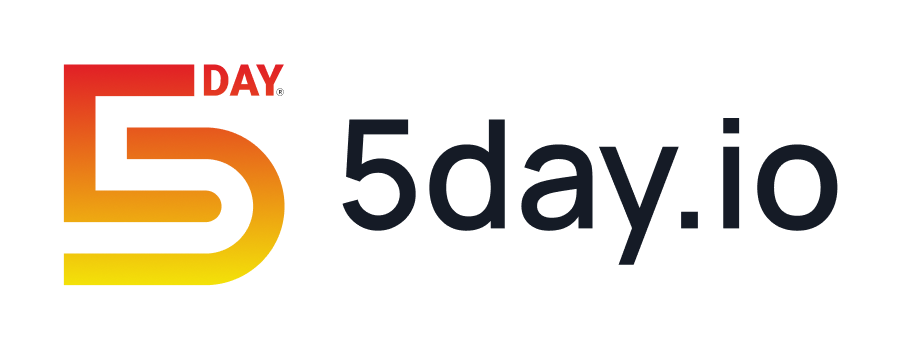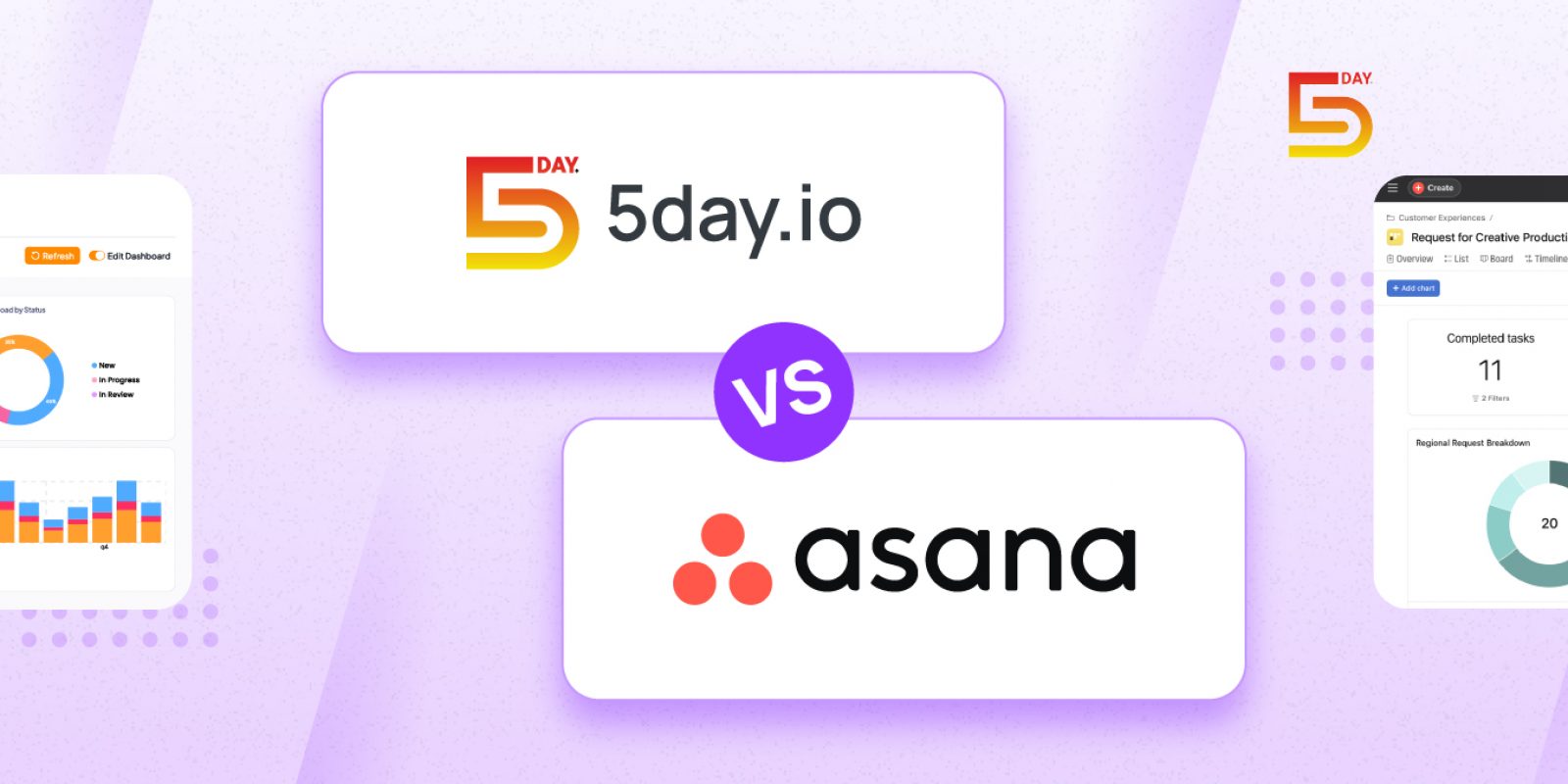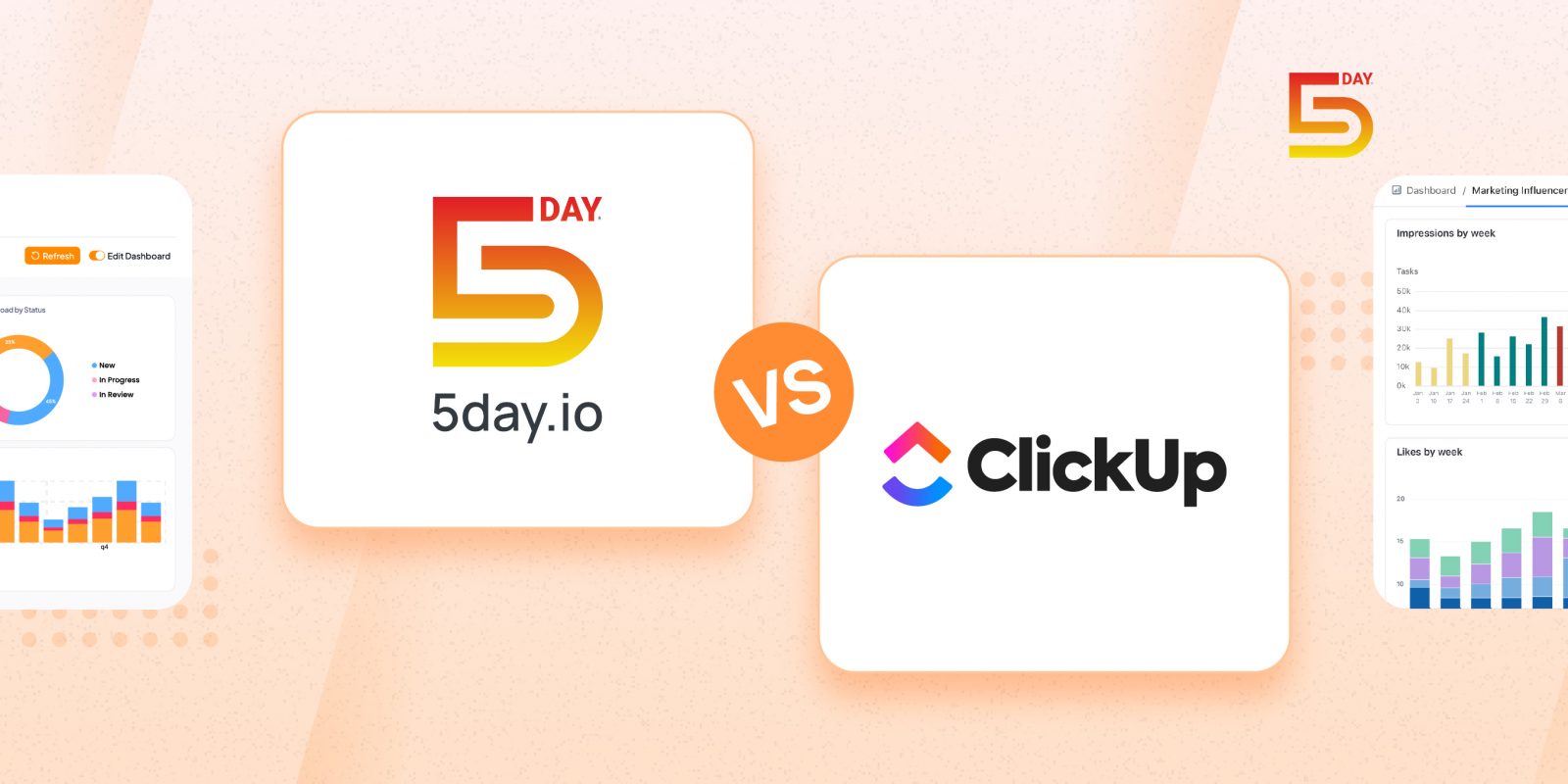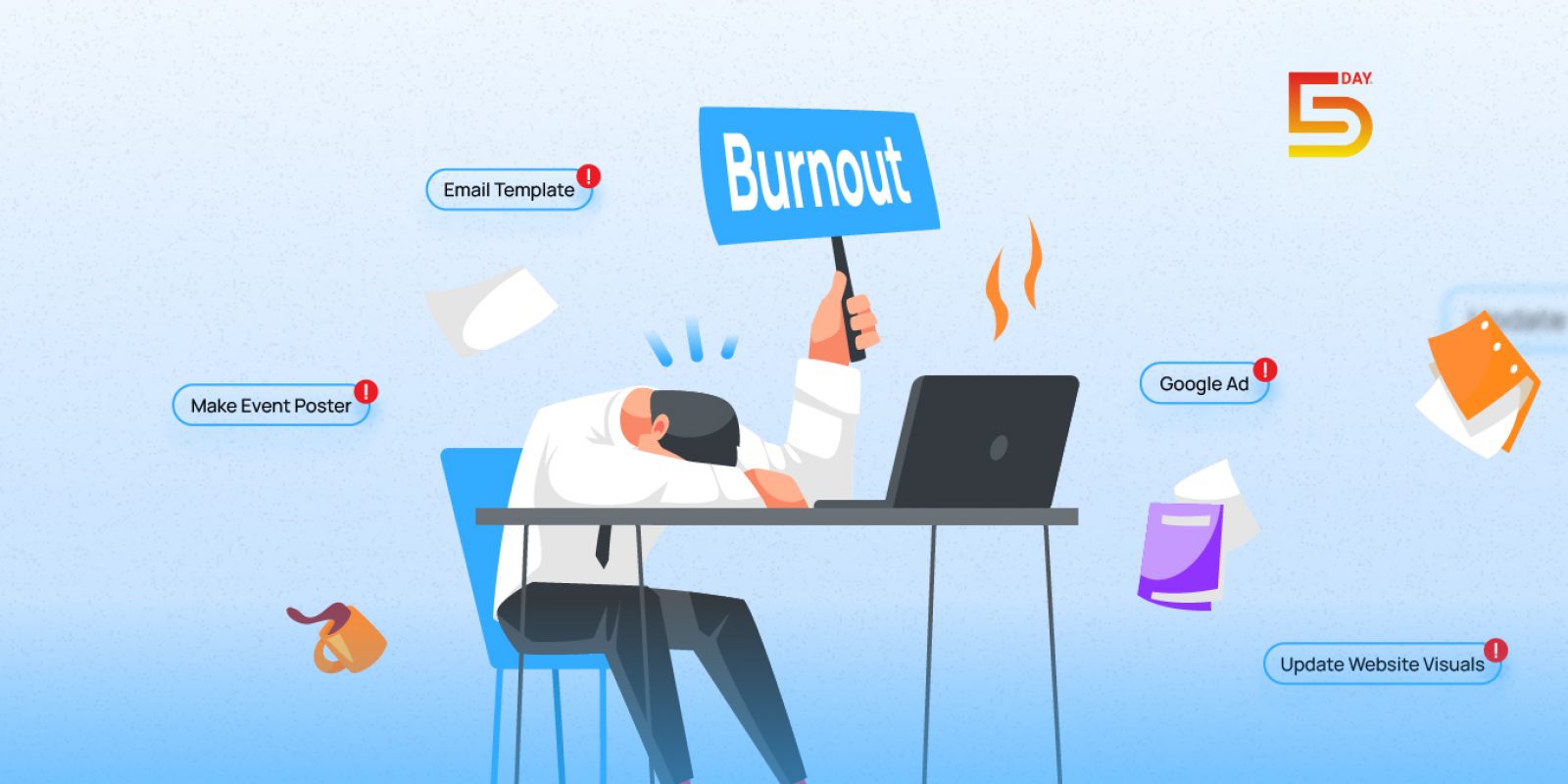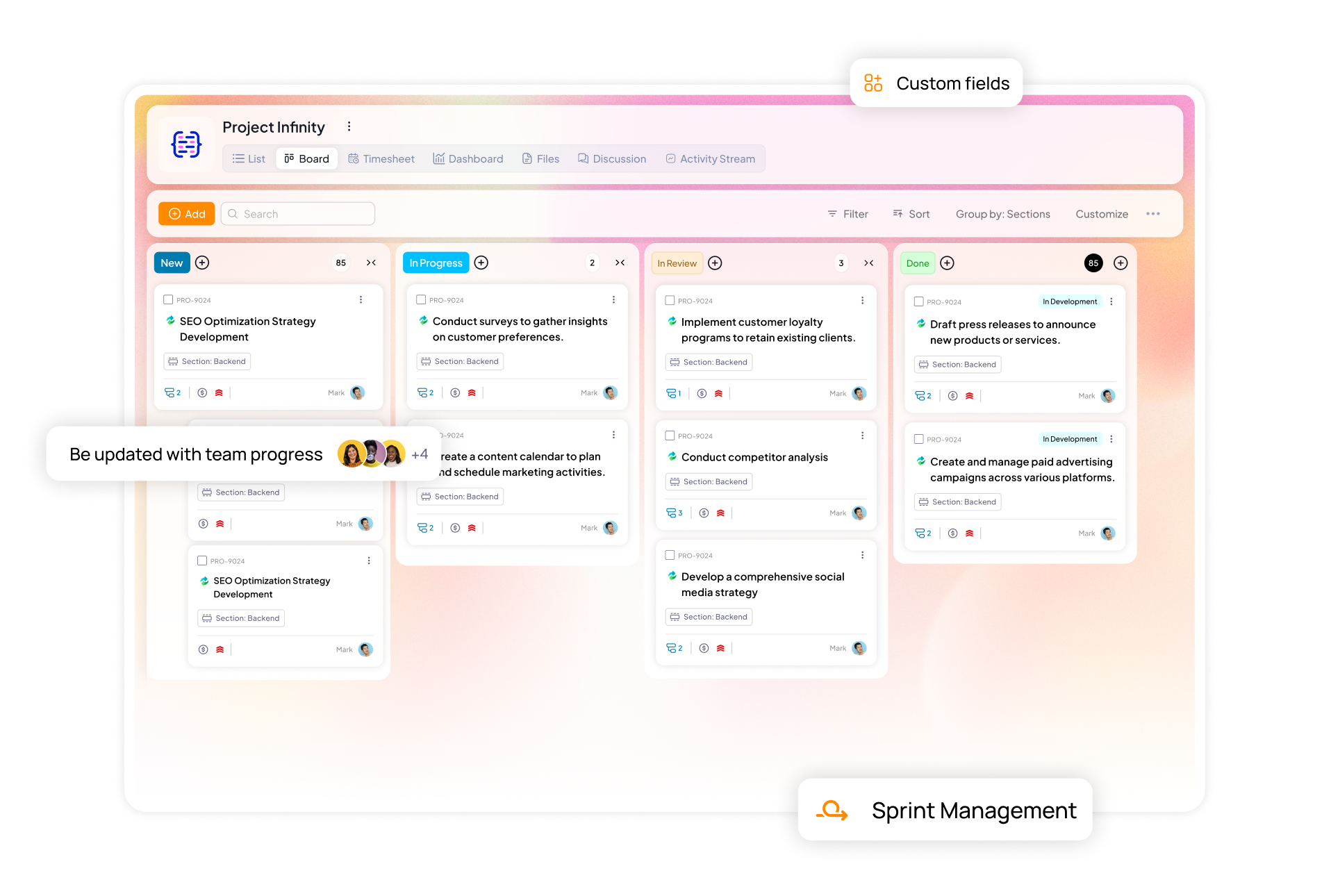Most of us in marketing agencies have lived on two sides of the equation. We’ve been in the launch that soared, where everyone knew what they were building, trusted one another, moved fast, and had each other’s backs.
We’ve also seen what happens when goals are foggy, roles unclear, or decisions scattered across emails and memory.
It’s in the latter scenario that creatives burn out, clients lose faith, and good work gets lost in a bad process. The one difference that creates a chasm between the two is how a marketing project kicks off?
We have a strong checklist handy, so you can start, sustain and scale strong. Whether you’re an agency, an in-house team, or a solo marketer for rallying partners, this article is your blueprint for starting strong.
Pre-kickoff preparation – Laying the groundwork
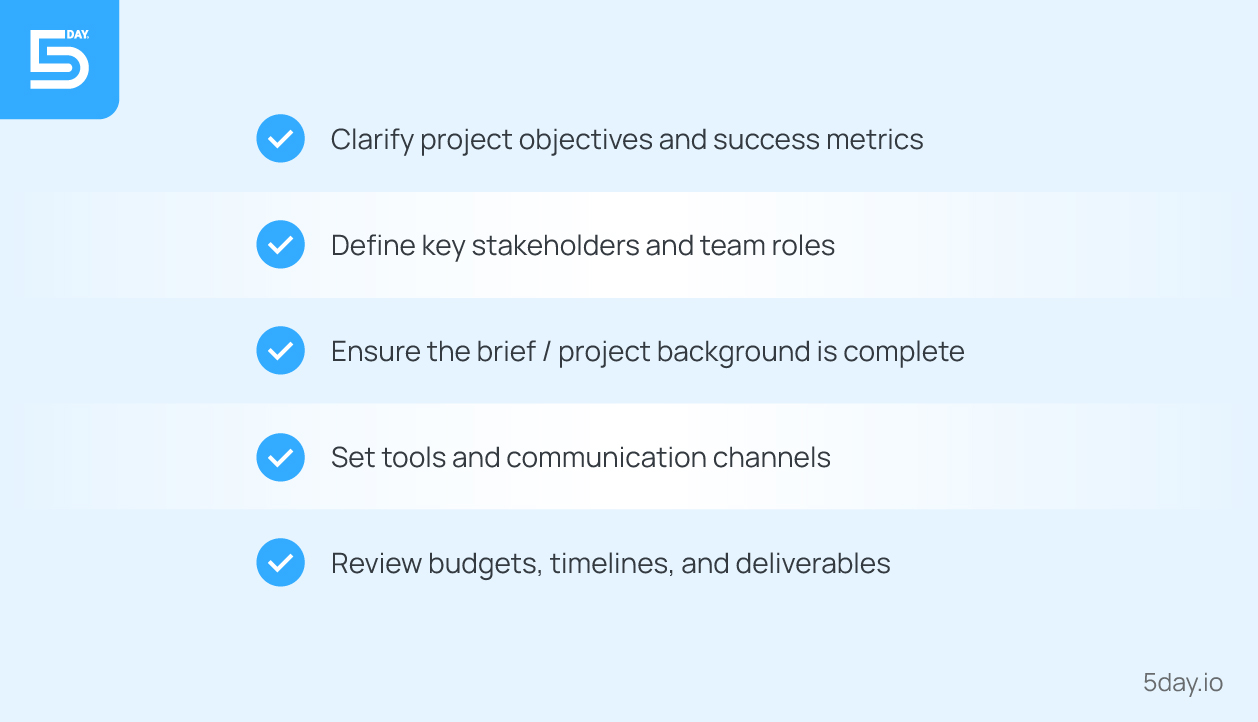
The marketing project kickoff meeting may be the first time a project is discussed out loud with the full team, but if you’re waiting until then to start planning, you’re already late. Most of the project’s success is determined in the quiet, often overlooked pre-kickoff project phase.
This is the point where miscommunication can be caught early, and energy can be focused.
Top marketing agencies treat this stage not as a checklist, but as the moment to get everyone facing the same mountain, so no one is climbing in the wrong direction.
1. Clarify project objectives and success metrics
Before any creative concepts are developed or timelines are built, one foundational question must be answered: what exactly are we trying to achieve? It sounds obvious, but this question often gets glossed over in the rush to get started.
A client may come in saying, “We want a great campaign,” and the team may nod and begin brainstorming visuals, taglines, and channels. But without a shared understanding of what “great” means, what outcome it’s supposed to create, every team ends up interpreting success in their own way.
This is why the pre-kickoff phase must begin with a slow, intentional conversation about objectives. A deep, meaningful discussion on the deeper “why” behind the project. Is this campaign intended to drive conversions? Build awareness? Reduce churn? Break into a new market? Each of those project goals requires a different creative and strategic approach.
2. Define key stakeholders and team roles
There’s nothing more frustrating than doing great work and then watching it get torn apart by someone you didn’t even know was involved.
The team’s almost done with the project deliverables, you’ve gone through rounds of internal and client feedback, and just when you think you’re ready to send it off, you’re in for a surprise. A mystery stakeholder appears out of nowhere with brand-new feedback that changes everything. Now the timeline is wrecked, your team is stressed, and no one knows who’s actually calling the shots anymore.
This chaos comes from skipping a step that sounds boring but is absolutely essential: defining roles and stakeholders before the kickoff.
When this part is neglected, all kinds of mess creeps in.
So, before you start building timelines or assigning tasks, sit down with your team and map it out.
- Who’s the internal lead for each stream of work?
- Who’s responsible for delivery, and who’s there to support?
- If feedback comes in late, who steps in to handle it?
- Who is the actual decision-maker?
- Are there legal or compliance reviewers involved?
- Are there brand gatekeepers who need to be included from Day 1?
A simple chart on a project management software, or a document (until every stakeholder is finalized) with names, roles, and who to loop in at each phase can save you countless headaches. Even better, walk through it with the client during your pre-kickoff sync.
Nine times out of ten, clients will actually thank you for setting up that kind of structure.
3. Ensure the brief / project background is complete
You’ve probably seen it before, A designer asked to create a landing page without knowing who it’s for. A copywriter asked to write a headline without any idea of the tone, audience, or offer. A developer told to build a feature that was described vaguely in an email two weeks ago. Everyone’s doing their best, but it’s like trying to navigate in the dark without a map. And eventually, someone stumbles.
This is why a complete, well-structured brief is the difference between a confident team that knows exactly where they’re headed, and a burned-out team stuck in endless revisions because they were never set up for success in the first place.
In the marketing project pre-kickoff phase, slow down and do the work to build a proper brief. Not just the creative brief, but the strategic story behind it.
Ask deeper questions like:
- What sparked this marketing project, was it a drop in sales? A reorg? A new competitor?
- What’s already been tried? What flopped?
- What internal politics are we stepping into?
- Who are the users and what do we know about how they behave, decide, and buy?
Also, is this marketing project proactive (e.g., a brand refresh with time to plan) or reactive (e.g., the CEO’s freaking out and needs something live in two weeks)?
That context radically changes how you structure timelines, resources, and expectations. A rushed, reactive brief demands tighter approval cycles and faster decisions. A proactive one gives more breathing room for exploration.
4. Set tools and communication channels
One teammate drops a link in Slack, another gives feedback in Figma, someone else replies in a 2 a.m. WhatsApp voice notes, and now no one knows what version is final, what decision was made, or where the client feedback even is.
Agencies today are running at lightning speed. Without clear rules around where things live and how information flows, even the most talented, well-meaning teams will find themselves confused and frustrated.
That’s why this part of pre-kickoff prep, agreeing on tools and communication rhythms is sanity saver.
Take a moment to define each tool’s role. For example: Slack is for quick questions and nudges, not for storing final assets. Project management tools holds the task status and deadlines. Notion is the home for SOPs and project docs. Google Drive is for all deliverables, organized by version and phase. Looms go in the weekly summary. Simple.
Start with a basic but powerful question:
- Where does the truth live? Is it a project management tool? A shared Google Doc? Figma comments?
- What about decisions? Are they made in meetings, or written down somewhere?
- How often do you check in?
- Will you have daily standups?
- Async weekly retros?
- Should updates happen in one thread, or are you cool with tagging on individual tasks?
- Do you use shared Slack channels with clients, or keep them in email only?
- Or do you use a comprehensive marketing agency project management software like 5day.io where you can store all information on all running projects?
5. Review budgets, timelines, and deliverables
After all, the client said the deadline was July, right? But did they mean July 1st or July 31st? Is that the go-live date or the final draft? These tiny question marks become massive roadblocks when they’re discovered too late.
So, in the pre-kickoff phase, get real about the budget and what it entails.
- Are there rounds of revision baked in?
- Are motion graphics or stock imagery covered?
- Is there room for a photo shoot or a UX audit, or are those out of scope?
- If there’s a possibility of expanding scope, what is the process?
- Are there hourly overages?
- Change requests?
Knowing this early lets your team protect their time.
Next, take a hard look at the timeline.
- Are there internal presentations or launches that your marketing agency supports?
- Are there dependencies on other vendors or teams?
- Does the project stall every time one stakeholder goes on vacation?
Read Also: What Are Project Dependencies?
Ask, “What’s your real drop-dead date?” And then work backwards, padding for review cycles, feedback loops, testing, and handoff.
Then there’s the question of handing over deliverables.
What are the actual, tangible things the client will walk away with? Three brand concepts and two rounds of revisions? One animated video, scriptwriting included? UX wireframes, but not the high-fidelity design? Get it in writing.
The project kickoff meeting – Crafting the kickoff meeting agenda
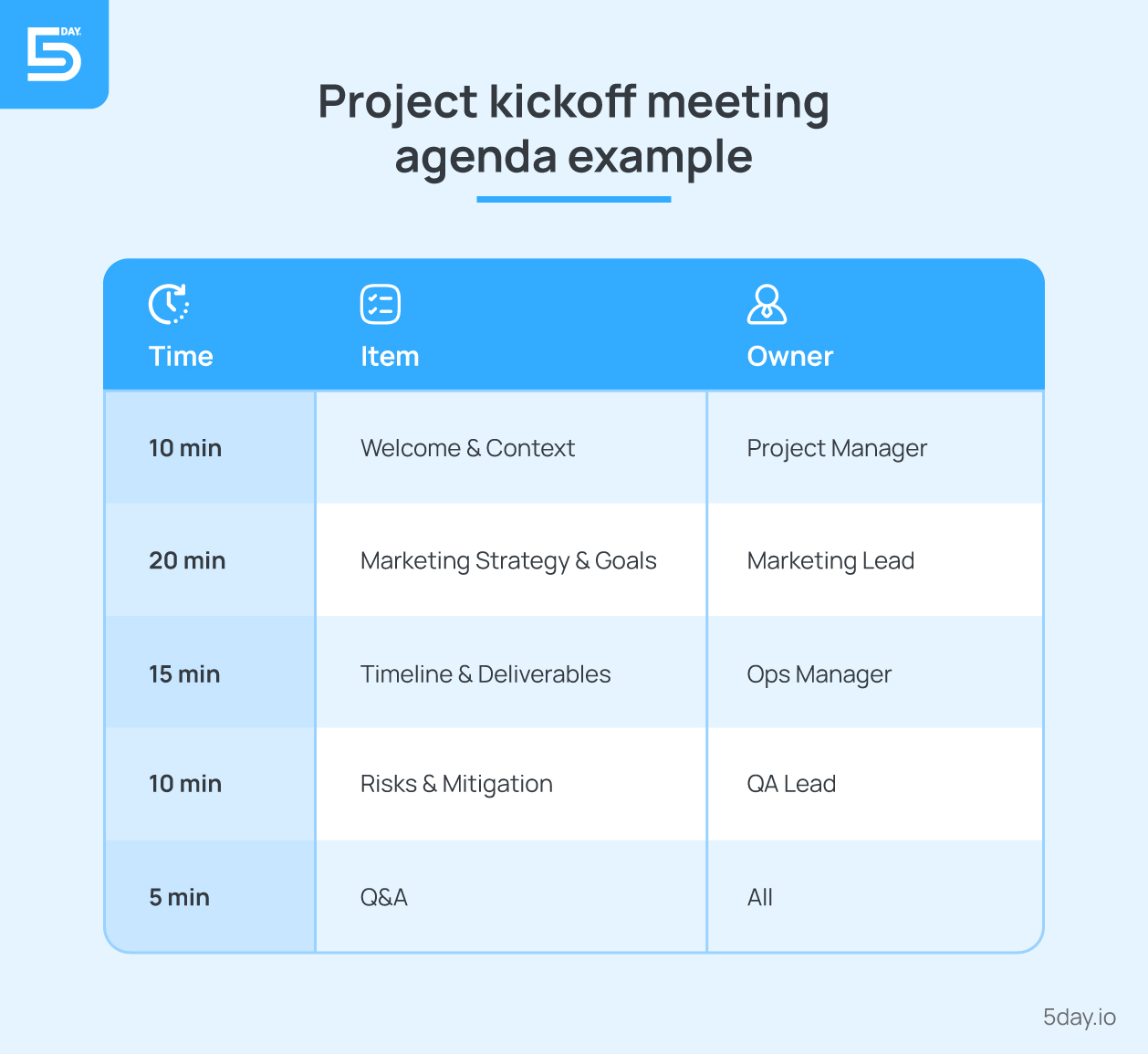
1. Meeting objective & Welcome note
Start the kickoff by setting the tone.
State the purpose of the meeting with intention: “This kickoff is where we all get on the same page about the goals, timelines, strategy, and ways of working, so we’re not just aligned on what we’re doing, but how we’re doing it together.”
A short welcome note, something as simple as “We’re really excited about this partnership and everything we’re building together”, helps shift the tone from transactional to collaborative. This is your chance to lay the emotional groundwork for the relationship.
2. Walkthrough of the marketing strategy/plan
If the plan is still evolving, be honest about what’s locked and what’s flexible. If testing is involved, outline the hypotheses. If budgets shape the strategy, say so. Transparency here builds trust.
3. Discuss timeline, milestones, and dependencies
Now it’s time to ground the strategy in reality. Outline the full project timeline, but don’t just list dates, tell the story behind the flow.
- Why are reviews scheduled when they are?
- Where are the bottlenecks?
- Which dependencies (like dev handoff, legal review, or third-party assets) could impact momentum?
Clarify the difference between internal milestones (like draft submission) and external deadlines (like a public launch). Show the checkpoints where you’ll pause to assess progress or gather feedback.
Agencies often assume the client will speak up if something’s off, but many won’t until it’s too late. Use this time to pressure-test the schedule together. Agree on what’s flexible and what’s locked.
4. Assign responsibilities and accountability
Next, get clear on who owns what, on both sides of the table.
- Who on the agency side owns strategy, creative, client communication, delivery?
- Who from the client side approves copies, supplies assets, or coordinates legal?
Clarify not just roles but also approval flows.
When responsibilities are clean and explicit, everyone breathes more easily. This part of the project kickoff agenda gives your project governance structure and rhythm.
5. Discuss risks, escalation paths, and QA expectations
You want to surface potential risks now, while they’re still theoretical.
- Are there dependencies on a vendor known to be slow?
- Is there a tight legal review window?
- Is the scope likely to change based on internal politics?
Bring these things up proactively. You’ll be surprised how often they say yes and thank you for asking.
Also clarify how escalation works.
- If something’s stuck or blocked, what’s the process?
- Who do you reach out to?
- What’s the acceptable turnaround time for urgent issues?
Establishing this early avoids awkward finger-pointing later.
Also, be upfront about QA ownership.
- Does your marketing agency do internal testing?
- Does the client do user testing?
- Is website staging access provided?
Talk through what quality looks like so there’s no mismatch at delivery.
The marketing project kickoff checklist
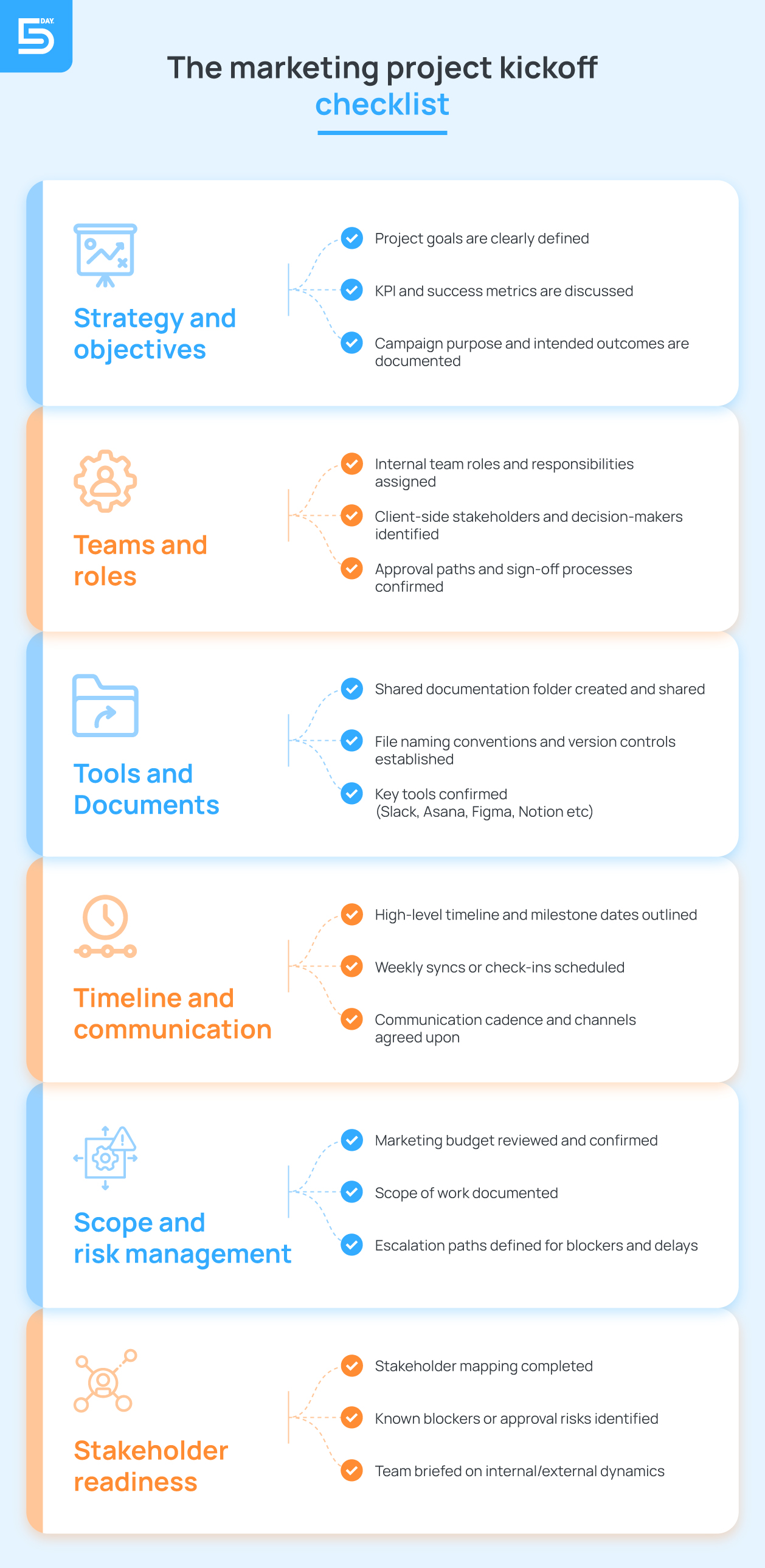
Post-kickoff follow-up – Maintaining momentum
The marketing project kickoff meeting is just the beginning. What happens in the days after determines whether all that alignment turns into real progress or fizzles out into scattered to-dos and stalled energy. This stage is where you shift from planning to execution. And that transition needs just as much care.
1. Send meeting recap and decisions summary
Once the marketing project kickoff meeting wraps, send a clear, well-organized recap, ideally within 24 hours. It creates a shared record of everything that was agreed on. Include key decisions, approved timelines, owners for each task, and any immediate action items. Think of this as your contract of clarity.
Marketing agencies often run into trouble when what was said in the meeting doesn’t match what people heard. A solid recap solves that.
Pro Tip 💡 |
Format it cleanly, bullet key points, and include links to the shared folder and project tracking board. It should be easy for anyone, stakeholder or intern, to read and instantly understand where things stand. |
2. Confirm task assignments in project management tool
Move the conversation into action by translating all agreements into tasks in your project management (PM) tool of choice.
5day.io is a lightweight yet powerful tool helps teams assign joint responsibilities with crystal-clear context, deadlines, and owners, so no task falls through the cracks. 5day.io allows you to break down every task with context, assign multiple collaborators, and set clear deadlines that show up where they need to.
What often derails projects post-kickoff is ambiguity. People hesitate when they’re unsure if something is theirs to do, or when a deadline is fuzzy. Make it clear. When your team opens the PM tool the next day, they should see a mapped-out game plan.
Read Also: Best Task Management Software
3. Set up reporting cadence
A strong reporting cadence lets your team show progress, flag risks, and stay aligned without endless meetings. Depending on the project size, this might vary between a weekly/bi-weekly status email, or a shared dashboard updated daily.
The important thing is consistency.
Everyone should know:
- What’s being tracked (tasks, KPIs, milestones)
- Where the status is visible (5day.io, GDocs, Slack channel)
- When updates are expected (every Friday? Monday mornings?)
Many marketing projects fail because updates fall off, clients go quiet, and no one notices the misalignment until it’s too late. Once you set this cadence upfront, you create a rhythm that sustains momentum and builds trust, internally and with clients.
4. Address blockers in a timely fashion
Blockers are inevitable, but how quickly you identify and resolve them determines whether they become minor detours or full derailments.
During the post-kickoff period, keep your radar on for friction points:
- Has someone not received key access or files?
- Is there confusion over task priority or scope?
- Are approvals delayed or feedback unclear?
If you see silence, or spiraling Slack threads, step in. Set the tone that it’s safe to raise blockers early. Encourage your team and clients to flag anything that might slow down the project. Then, resolve it fast. Escalate internally if needed.
One of the most powerful habits in your checklist for starting a new marketing project is building a culture where blockers are dealt with openly.
5. Keep communication loop active
The days and weeks following kickoff often determine the emotional tone of the entire project.
Don’t disappear after the marketing project kickoff. Keep checking in, celebrate small wins, highlight progress, and share updates regularly, even if it’s just a “we’re on track” note. A short message like, “Hey, just checking in, anything you need from us to move forward?” can make all the difference.
Tips for a successful marketing project kickoff
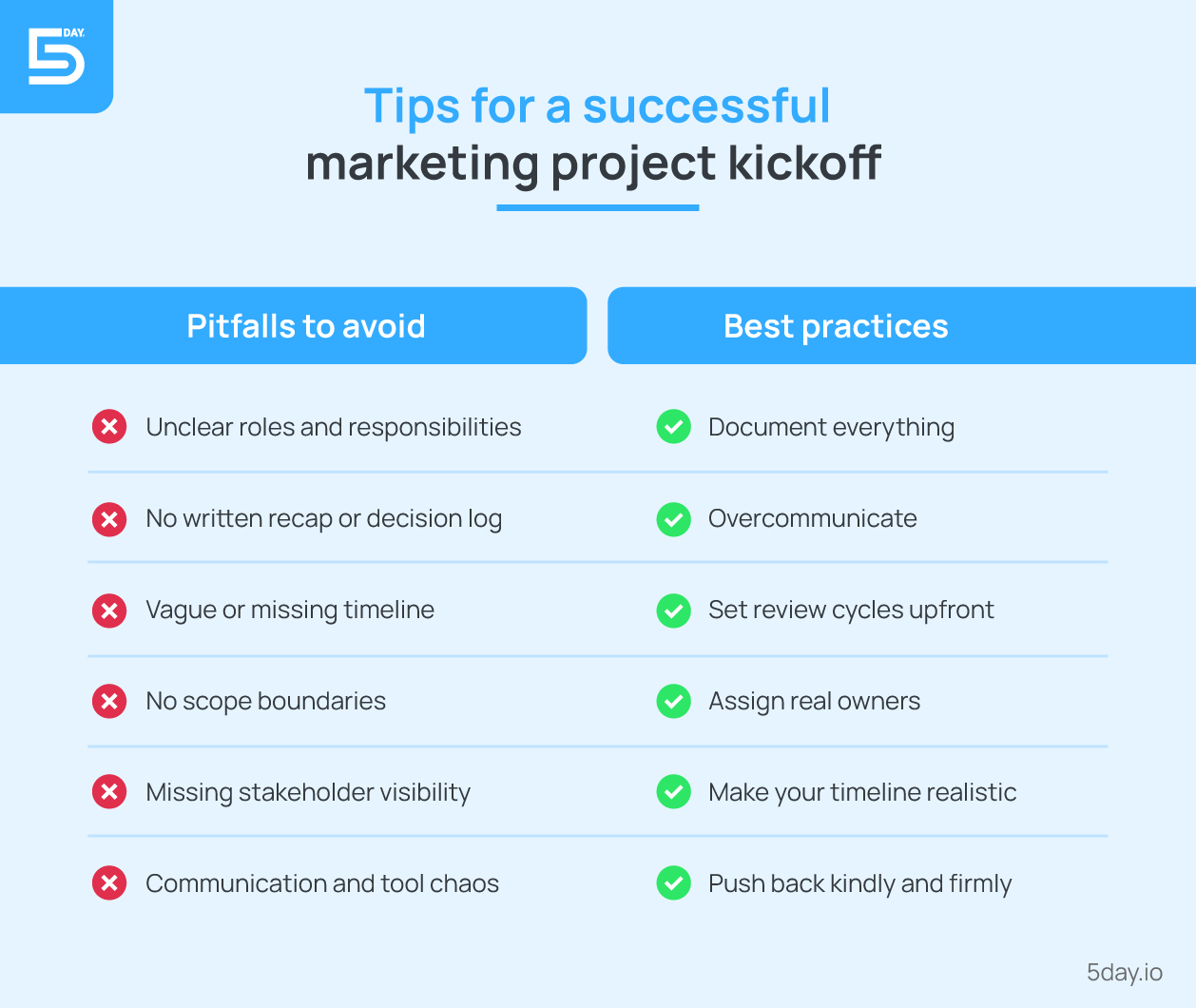
Great marketing projects start with a structure. Below are powerful habits and frameworks that help teams feel confident from the beginning.
1. Document everything
Start a centralized source of truth. document decisions, task owners, meeting notes, timelines, goals, scope agreements, file links, and review cycles. This eliminates ambiguity and saves the team hours of back-and-forth.
2. Overcommunicate (Especially early)
In the first few weeks, clarity is everything. Recap meetings. Repeat deadlines. Confirm feedback is received. Don’t be afraid to say, “Just repeating this to make sure we’re aligned.” It might feel like overkill, but it builds momentum and trust.
3. Set review cycles upfront
Don’t wait until the final delivery to get input. Agree on review checkpoints if you’ll share the first draft on Thursday, feedback by Monday, final by next Friday. This keeps the project moving and avoids endless back-and-forth with unclear expectations.
4. Assign real owners
Go beyond the design team or the client. Use names. Who exactly is writing the copy? Who’s giving final sign-off? Who’s responsible for chasing feedback if it’s late? The more specific, the better. Clear owners reduce mental load for the whole team.
5. Make your timeline realistic
Clients love ambitious timelines, and teams love to please, but unrealistic timelines kill morale. Leave room for review rounds, delays, or unexpected pivots. A slightly longer but more stable project plan builds more trust than an overly optimistic one that breaks down halfway.
6. Push back kindly and firmly
It’s easy to overpromise at kickoff. But setting honest scope boundaries shows professionalism. Be clear about revision rounds, included formats, or additional charges for extra asks. It avoids awkward conversations down the line.
How Can 5day.io Help You Give a Fantastic Project Kickoff to Your Clients?
A disorganized, unclear kickoff can lead to weeks of confusion. But a powerful one lays the foundation for trust.
That’s where 5day.io comes in to turn your marketing project kickoff from just another meeting into a moment your client will remember.
With 5day.io, you’re never scrambling to pull together documents or rehash old notes. Instead, you walk in prepared with smart, reusable kickoff templates tailored to marketing projects, client onboarding, or complex launches. You can use templates already embedded onto the platform or create your own and save them for similar projects.
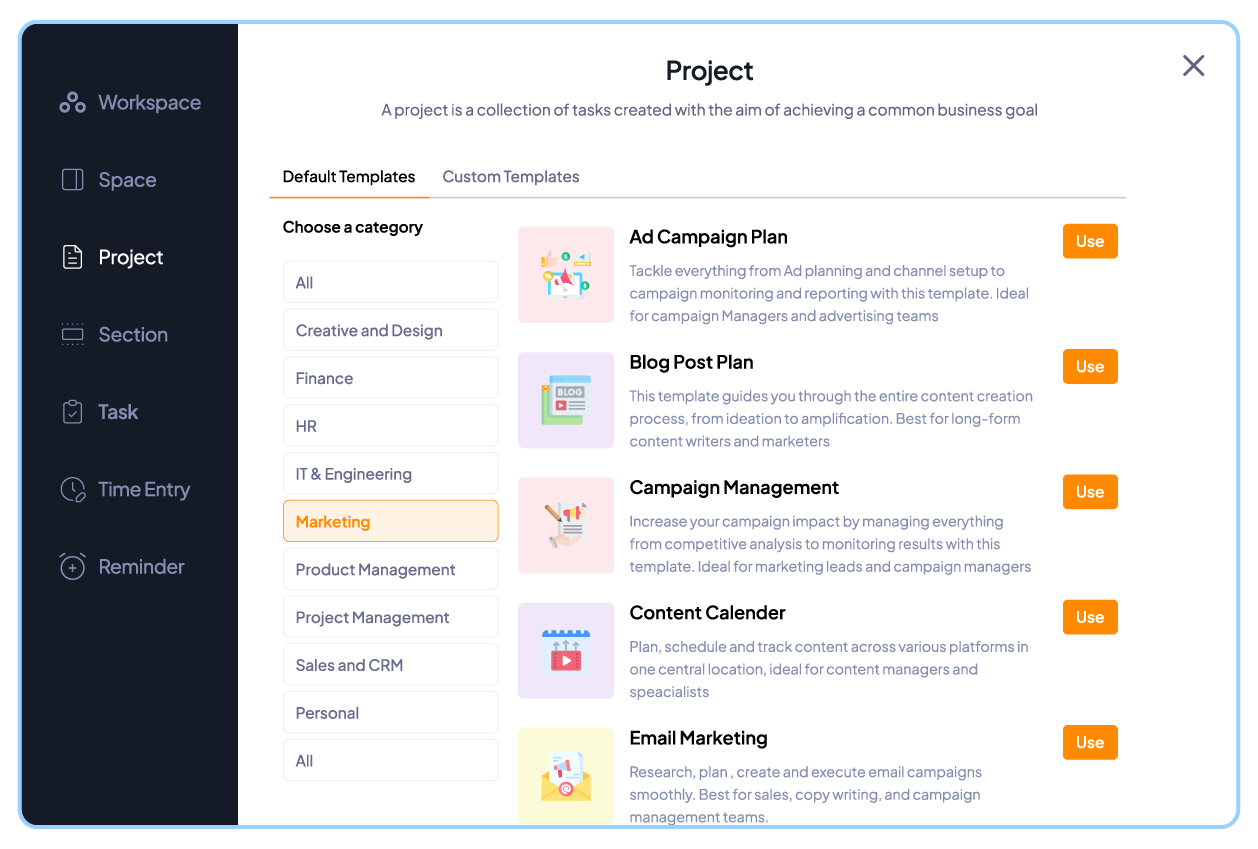
Then, the marketing project kickoff meeting becomes something more. 5day.io’s helps you add context to discussion points, assign owners on the fly, track time, and attach relevant docs. Your kickoff becomes alive, and memorable.
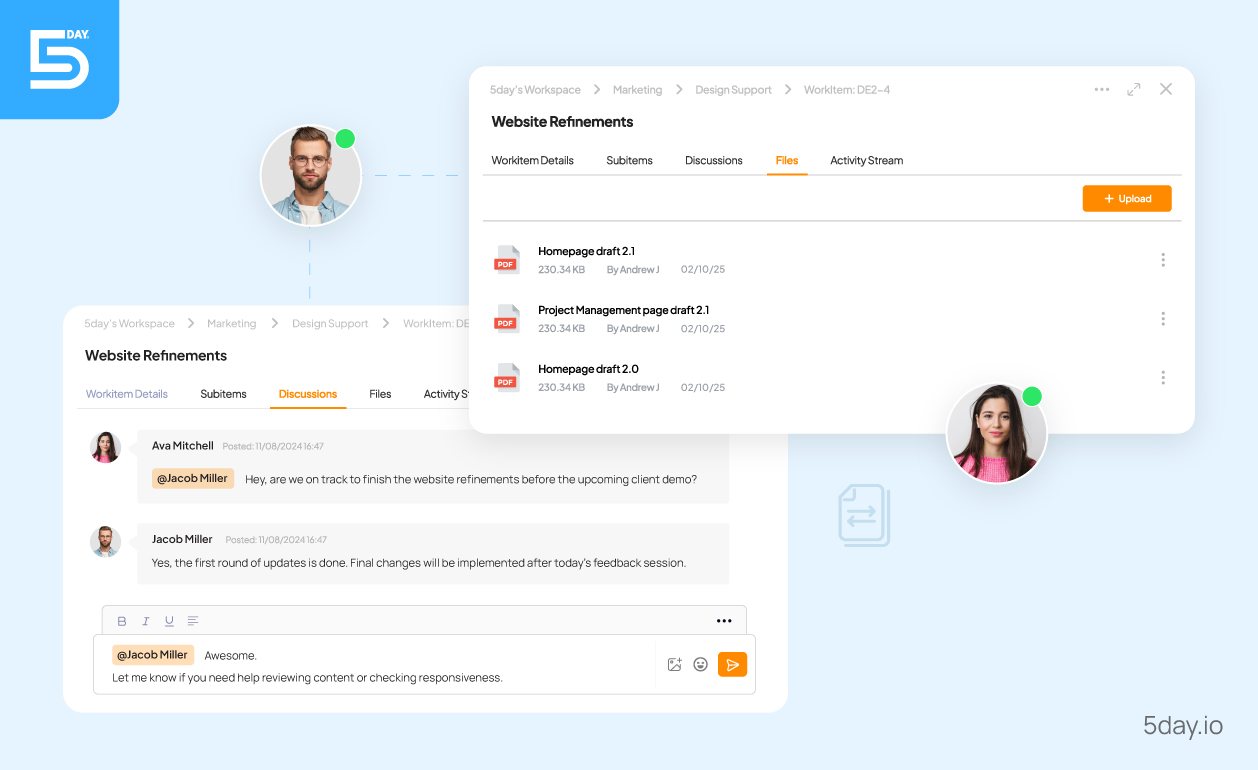
And the best part? Everything you decide in the room becomes actionable. Instantly.
Your clients feel confident and seen. Kickoffs are primarily for building trust and 5day.io lets you share client-facing dashboards right after the meeting. They are beautiful visual summaries of goals, deliverables, timelines, and ownership. Your client feels valued, and assured they chose the right partner. That’s how loyalty begins.
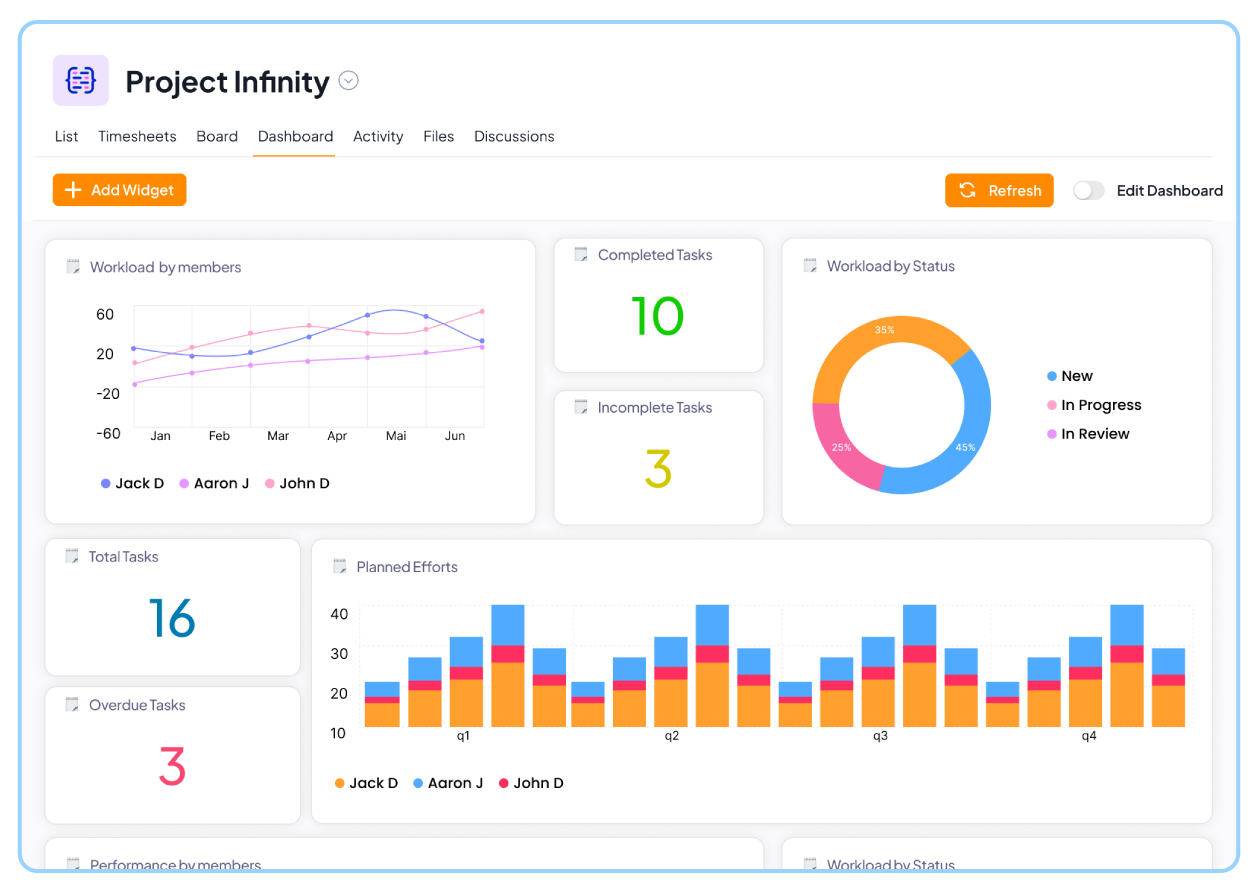
Often, the biggest cracks appear when a client is handed off from sales to delivery. But with 5day.io, that handoff becomes invisible. Your pre-sales insights, proposals, and expectations flow directly into the kickoff framework, so your delivery team steps in with full context.
Try 5day.io for free for 30 days with full access to high-end features and give your clients a first impression that actually lasts.
